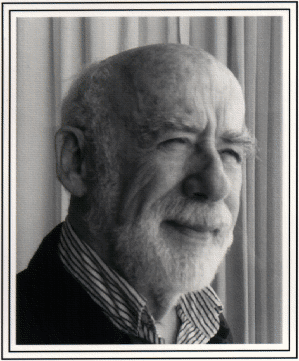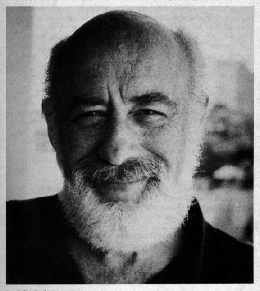
SEPTEMBER 2007

DR. JOHN W. GOFMAN
August 26th, 2007
By Ace Hofman
On August 15th, Dr. John W. Gofman died of heart failure at 88.
In the field of Nuclear Physics analysis he was the best, and so naturally, the Nuclear industry hated him, denounced him, tried to discredit him, and, whenever possible, ignored him.
They hated him because they could not disprove his theory that low level radiation was a lot more harmful than officially recognized, and potentially deadly down to the last radioactive atom. He spent decades developing statistical proofs based on epidemiological studies. He turned out to be right.
|
They hated him because he had been one of their own --
and in fact, one of their best.
During World War II, while still a graduate student at
Berkeley, Gofman isolated the first usable quantities of
Plutonium-239, for use in the Manhattan Project that
developed the atomic bombs that were used at the end of
the war.
By 1978 (when he had to submit an affidavit in a nuclear
case) he had published over 150 scientific papers on the
following topics:
(1) Lipoproteins, atherosclerosis, and coronary heart
disease.
(2) Ultracentrifugal discovery and analysis of the serum
lipoproteins.
(3) Characterization of familial lipoprotein disorders.
(4) The determination of trace elements by X-ray
spectrochemical analysis.
(5) The relationship of human chromosomes to cancer.
(6) The biological and medical effects of ionizing
radiation, with particular reference to cancer, leukemia,
and genetic diseases.
(7) The lung-cancer hazard of plutonium.
(8) Problems associated with nuclear power production.
At the time his honors and awards included the
Gold-headed Cane Award as a graduating senior from UC
Med. School in 1946, the Modern Medicine Award in 1954
for outstanding contributions to heart disease research,
the Lyman Duff Lectureship Award of the American Heart
Association in 1965 for research in atherosclerosis and
coronary heart disease, the Stouffer Prize (shared) in
1972 for outstanding contributions to research in
arteriosclerosis, and in 1974, the American College of
Cardiology selection as one of 25 leading researchers in
cardiology of the previous quarter century.
He also was Associate Director of Lawrence Livermore
Laboratory from 1963 to 1969 and holds three
patents. One is on the slow and fast neutron
fissionability of Uranium-233, one is on the sodium
uranyl acetate process for separation of plutonium from
uranium and fission products from irradiated fuel, and
one is on the columbium oxide process for the separation
of plutonium from uranium and fission products from
irradiated fuel.
Regarding nuclear weapons testing, he wrote:
"I am prepared to defend, before any scientific
body, and under oath in full public view, my estimate
that ONE MILLION people (perhaps only 500,000 or as many
as two million) in the Northern Hemisphere have been
irreversibly condemned to die of lung cancer from those 5
tons of plutonium. Indeed, were it not for the fact
that by far MOST of the plutonium fell either upon the
oceans or uninhabitable land, the figure of one million
would be enormously larger." ("Irrevy" by
J.W. Gofman, 1979, page 39.)
Dr. Gofman's estimates were based on the concept that a
given quantity of plutonium, if divided among 1, 2, or
any number of people, will have (statistically speaking,
of course) approximately the same effect, that is, that
on average one person will die from a "lethal
dose" of plutonium, whether that plutonium is all
given to one person or divided out among many people.
He was co-discoverer of Uranium 233 and the first of the
three patents in his name, on the slow and fast neutron
fissionability of Uranium 233, was described by former
AEC chairman Glenn T. Seaborg as being worth in the
neighborhood of "a quatrillion dollars" to the
nuclear power industry.
Gofman also developed (in 1943) the chemical techniques
to deliver the first milligram-quantities of plutonium to
J. Robert Oppenheimer. Prior to that, all anyone had were
microgram quantities, but "Oppy" needed
milligrams, and he went to Gofman for it, who was a
graduate student at Berkeley at the time. Gofman produced
more than twice the amount his friend "Robert"
needed and was able to keep the rest to play with for
himself. (Okay, Okay. It wouldn't be my choice of toy
either.)
Gofman was the Chairman of the Committee for Nuclear
Responsibility, which he founded in 1971. CNR is a
non-profit, educational group organized to provide
independent analyses of the health effects and sources of
ionizing radiation. Gofman was also Professor
Emeritus in Molecular and Cell Biology, University of
California at Berkeley. While at Livermore National Lab
in 1963 he established the Biomedical Research Division
where he examined the health effects of radiation and
studied chromosomal origins of cancer. He authored six
books on the health consequences of ionizing radiation --
in 1981, '85, '91, '94, '98 and '99, with various updates
into the new millennium.
| Prof Gofman speaking
at a Lawrence Berkeley National Laboratory
symposium: In the early days of the postwar period, when radioactivity became available in large quantities as a result of the existence of nuclear reactors, many people working in the field said, “Well, what dose can we allow people to have which will be safe? I wrestled with this question for over twenty years. In 1986, in a talk about Chernobyl, I presented to the American Chemical Society my initial calculations which said there cannot be a safe dose, because at the lowest possible dose, which is one radiation track through a cell, I have proved that cancer is a result. Many people thinking about tritium say, “Oh, we don’t have to worry about tritium! The energy of the radiation is so low that we don’t even need to think about it.” It is true that the energy of each beta particle emitted by tritium is very low. But there’s another part. When you have a very low energy bata particle interact with biological tissue to produce damage to genes, the damage to chromosomes, and the risk of future cancer. . . .Well, the lower the energy of the radiation, the worst it is in terms of biological hazard. Tritium is five times as hazardous as bomb radiation for the same total amount of energy given. I don’t think any person who’s reasonable at all can doubt that I have demonstrated there is no safe dose! I have shown with a multitude of studies that we get cancer down to the lowest doses. Now, that been resisted, but let me tell you something—it has been resisted, but the United Nations Scientific Committee in 1993 has come out and joined me in exactly the same analysis. Their conclusion: there is no safe dose. In 1995, the National Radiological Protection Board of Great Britain has come out with the same sort of analysis. The question comes up often in people’s minds, “Are all people equally sensitive to radiation in the form of injuries from radiation? And the answer is no. The children are most sensitive with respect to the generation of cancer and leukemia from radiation. A study of breast cancer in Hiroshima with radiation from the bomb has shown that children and girls under 20—women under 20—are the most sensitive to breast cancer generation, and beyond 40 even less sensitive. And when I say they are, I am not speculating. That’s a fact, and the sensitivity of the young being greater means we should exercise every precaution that we protect our children from sources of radiation, no matter how small. We need to remember that the work of the Lawrence Lab and laboratories like that throughout the country, is for service to the public. And therefore service to the public should be done with the utmost concern for the public’s safety and health. |
Scientific studies conducted over the past few decades
have borne out Gofman's warnings. Even the latest
"BIER" study (BIER VII) agrees that there is no
safe dose -- no threshold -- below which radiation is not
harmful and cannot cause cancer, leukemia, heart
problems, birth defects, and literally hundreds of other
ailments.
I met Dr. Gofman after he spoke in New York City, around
1979 or 1980. I sent him several of my first essays
on nuclear power, which he approved of. We spoke by
phone occasionally after that, but often at length when
we did speak, and he always remembered the details of the
previous conversations far better than I did -- and yet I
was the one in awe, hanging onto every word! His
mind was amazing. He counted as his friend -- not
just his colleague and certainly not just his adversary
-- such men as Glenn Seaborg. The last time Gofman
and I spoke was probably about 10 years ago, and at that
time, nearing 80, he was working feverishly on additional
epidemiological studies of the health effects of x-rays
given by the medical community. Since then, average
dose rates for individual medical procedures have
continued to drop, as better technology has been
developed and the dangers of "LLR" (low-level
radiation) has become more and more undeniable.
That trend continues, but slowly.
Activists have used Gofman as a "litmus test"
to determine who the spies, infiltrators, agitators,
provocateurs, and paid disrupters are in their
group. These people will always tell you that
"Gofman has been discredited."
In fact, Gofman never was discredited, and his research
stands. Radiation is dangerous down to  the last decay, and Gofman is
our hero. His work on the Manhattan Project
should have made him a hero to the rest of society, as
well, but America doesn't like anyone who questions the
standard dogma of the nuclear age, so he was never
recognized for his contributions to our understanding, or
his vital contributions to the war effort.
the last decay, and Gofman is
our hero. His work on the Manhattan Project
should have made him a hero to the rest of society, as
well, but America doesn't like anyone who questions the
standard dogma of the nuclear age, so he was never
recognized for his contributions to our understanding, or
his vital contributions to the war effort.
An American icon and unsung hero had faded away.
Rest In Peace, John. We loved you.
Ace Hoffman
Carlsbad, CA
(Portions of the above were created from previous essays
about Dr. Gofman.)
My
favorite scientist